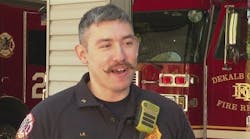If firefighter are not rehabilitated, the probability for ineffective performance, mistakes, accidents, injury, and even death escalate.
It's been stated that "once firefighters are exhausted, it takes hours if not days for them to recover" . Yet another source can be cited that proclaims "rehabilitation practices are not limited to the fire service"; citing sports, utility, petroleum, mining, construction and similar industries as having the need for similar rehabilitation processes. Bottom line, according to the United States Fire Administration:
the physical and mental demands associated with firefighting and other emergency operations, coupled with the environmental dangers of extreme heat and humidity or extreme cold, create conditions that can have an adverse impact upon the safety and health of the individual emergency responder."
Why is rehabilitation important?
A key responsibility for all fire officers, at every incident you respond to, is to keep your personnel as safe as possible and make sure "Everyone Goes Home" from the incident. To keep personnel safe and "fresh" at an incident, work rotation becomes very important, but is also difficult to achieve in many cases.
Unlike sprinkler systems that continue to operate until the water supply is exhausted, the system is shut down, or the fire overcomes the system; firefighters reach a limit on how long and how well they can perform. This is generally agreed to involve the two air bottle rule, which equates to about 45 minutes. Recognize though that this is not a hard and fast rule. Some firefighters may only last 20 minutes. The fire officers must know their personnel's capabilities and how long they can perform and what the individual's limitations are.
Once a firefighter has reached their performance limit, they need to be rehabilitated. If they are not, the probability for ineffective performance, mistakes, accidents, injury, and even death escalate.
How is Rehabilitation Handled?
The United States Fire Administration, in their document Emergency Incident Rehabilitation, defines seven components to rehabilitation. They include:
Sectoring - Similar to any other incident, when conditions and situations dictate, officers should establish a rehabilitation sector/group/area to facilitate personnel into the process of rehabilitation.
Hydration - Water and electrolytes must be replaced in your body to prevent heat injury. The rehab sector is the location to assure proper hydration occurs. Cold weather events, despite cold outside temperatures, have the same heat body stress scenarios as hot weather, and necessitate the rehabilitation of firefighters.
Nourishment - As a general rule, events lasting over three hours necessitate food be provided. Similar to fluids, there are certain foods that are recommended for use and others that you should refrain from using. Consult your medical director or USFA data for more details.
Rest - For firefighters, the USFA suggests the "two air bottle rule" or 45 minutes of working time as an acceptable level of work prior to mandatory rehabilitation, or sooner if the individual firefighter shows signs of stress or complains.
Recovery - When recovering from extreme exertion in a rehab area, it is important to not move immediately into a cold area from a hot area. The body needs to cool down appropriately, hydrate, and not be in a position where drugs impair the body's ability to sweat. All of this necessitates a recovery process that is monitored by individuals who can take appropriate action if necessary.
Medical Evaluation - Three components are necessary for this aspect. First, EMS should be provided who are trained in appropriate rehab processes and can take action if necessary, monitoring of the firefighters must be conducted and all evaluations need to be documented.
Accountability - Firefighters assigned to rehab should enter and exit the area as a crew and be documented for accountability purposes when they enter rehab and are released.
Of course, these are just the basic concepts of what a rehab plan should include. You are encouraged to consider these issues and more, as local situations dictate.
FEMA/NFFF Firefighter Life Safety Initiatives
FEMA and the National Fallen Firefighters Foundation (NFFF) have been conscientiously working on a series of firefighter life safety initiatives for over a year, with the objective of reducing firefighter injuries and deaths. A component of these initiatives involves firefighter rehabilitation guidelines.
These guidelines are consistent with what has been discussed earlier, and focus on:
- Stop Before You Drop
- Cool down, when hot
- Warm up, when cold
- Dry off, when wet
- Stay Hydrated (with non-caffeinated drinks)
- Monitor Vital Signs
These guidelines apply to individuals and officers, to take responsibility for and rehabilitate before it is too late.
What to do next?
To manage the issue of firefighter performance, safety in operations, and make sure "everyone goes home", fire departments should have standard operating procedures/guidelines (SOP/SOG) for rehabilitation. Basing the SOP/SOG on NFPA 1584, "Rehabilitation of Members Operating at Incident Scene Operations and Training Exercises", the SOP/SOG should follow the components described previously in this article. If you are looking for assistance in developing the procedure/guideline or looking for more information, it is just a phone call or computer click away. FEMA/USFA document FA-114 Emergency Incident Rehabilitation offers an excellent explanation of the issue and provides key information for you to develop an Emergency Incident Rehabilitation SOP/SOG for your operation. The next step is yours!
Lesson #22
Once a firefighter has reached their performance limit, they need to be rehabilitated. If they are not, the probability for ineffective performance, mistakes, accidents, injury, and even death escalate.
Safety 101 - A new series from the technical and administrative perspective, designed to help you reduce emergency responder injuries, illnesses, property loss and death!
Related Safety 101 Articles:
- Safety 101: An Introduction
- Safety 101: Lesson 1
- Safety 101: Lesson 2
- Safety 101: Lesson 3
- Safety 101: Lesson 4
- Safety 101: Lesson 5
- Safety 101: Lesson 6
- Safety 101: Lesson 7
- Safety 101: Lesson 8
- Safety 101: Lesson 9
- Safety 101: Lesson 10
- Safety 101: Lesson 11
- Safety 101: Lesson 12
- Safety 101: Lesson 12
- Safety 101: Lesson 13
- Safety 101: Lesson 14
- Safety 101: Lesson 15
- Safety 101: Lesson 16
- Safety 101: Lesson 17
- Safety 101: Lesson 18
- Safety 101: Lesson 19
- Safety 101: Lesson 20
- Safety 101: Lesson 21
DR. WILLIAM F. JENEWAY, CSP, CFO, CFPS, a Firehouse.com Contributing Editor, is Executive Vice President of VFIS and has over 30 years experience in safety and risk management in the insurance industry. He was named "Volunteer Fire Chief of the Year" as Chief of the King of Prussia, PA, Volunteer Fire Company, and is the author the text Emergency Service Risk Management. He has partipated the NVFC Corner podcasts on [email protected]. To read William's complete biography and view his archived articles, click here.





